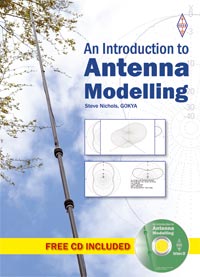 W5GI's “Mystery Antenna” gets a lot of attention. Possibly because of its daft name.
It looks like a G5RV, but W5GI (now SK) used coax stubs to give what he called “a coaxial colinear array on 20m”. It consists of a half wave length (at 20m) of 300 Ohm ribbon that feeds a dipole centre.
Either side of the dipole centre are two pieces of wire 16ft 6in long.These are then each connected to the inner of a 16ft 6in piece of RG58 coax. The outer is left unconnected. The far end of this is then shorted and connected to a further 16ft 6in of wire, giving an antenna with a total span of 99ft.
I've now been using one for about three months, so find out what I think of it, is it really a "mystery" and is it worth making one!
Download the report.
Update: I have been doing some more modelling with the antenna as an inverted V and if mounted at about 10m with the ends at 3m you'll find that the lobes vanish and it becomes pretty omnidirectional at higher frequencies. On 20m you may find it radiates best broadside to the wire and less off the ends - this seems to match what I have found. Plots for 20m and 10m Inverted V have been added to the report.
W5GI's “Mystery Antenna” gets a lot of attention. Possibly because of its daft name.
It looks like a G5RV, but W5GI (now SK) used coax stubs to give what he called “a coaxial colinear array on 20m”. It consists of a half wave length (at 20m) of 300 Ohm ribbon that feeds a dipole centre.
Either side of the dipole centre are two pieces of wire 16ft 6in long.These are then each connected to the inner of a 16ft 6in piece of RG58 coax. The outer is left unconnected. The far end of this is then shorted and connected to a further 16ft 6in of wire, giving an antenna with a total span of 99ft.
I've now been using one for about three months, so find out what I think of it, is it really a "mystery" and is it worth making one!
Download the report.
Update: I have been doing some more modelling with the antenna as an inverted V and if mounted at about 10m with the ends at 3m you'll find that the lobes vanish and it becomes pretty omnidirectional at higher frequencies. On 20m you may find it radiates best broadside to the wire and less off the ends - this seems to match what I have found. Plots for 20m and 10m Inverted V have been added to the report.
Further update: I have now included the original CQ magazine constructional info in the PDF. I can also confirm that the 50 Ohm resistor method I suggested to determine the exact half-wave electrical wavelength on 20m works a treat as I have just built another one.










One would save a lot of time and headaches just putting up an 88' doublet fed with window line or even 300 ohm ribbon, especially on 20 meters.
ReplyDelete73!
Very true - people seem to want to shy away from doublets and open wire feeder. I think it is because of the increase in automatic tuners with unbalanced output.
ReplyDeleteSteve G0KYA
People who are used to coax have a lot of problem understanding open feeder. It took me a while to work it out but once I got it, everything clicked.
ReplyDeleteI set up a doublet at the local club which turned out to be poorly located and really not long enough and unfortunately the perception was that the feeder was rubbish. I heard comments such as "Why are we using this crap?" and "We should take this sh*t off and feed it with coax". I will add that we were using a true balanced feed tuner.
The whole balanced/unbalanced thing can be quite difficult to understand. The natural way to look at open feeder is that "it must be rubbish because it's not screened, coax is screened so therefore it's better" but of course that's not true.
Try getting that across though, it's a real uphil struggle. I'd explained it fully before I put up the doublet but still got those comments above.
73
Keith.
I built and tested the W5GI antenna. It soon became problematical. Coax would corrode, the length of the flat lead to get it to work seem to be a mystery. It sagged more. Wound up trashing it. Now I use a simple 110 ft center fed Zepp fed with 450 flat lead along with with an antenna tuner. This works much better overall and no maintenance problems.
ReplyDeleteWhere is the PDF of the original CQ article you said you have included? Link?
ReplyDeleteJust download the report linked to in the story above - it is towards the end.
DeleteSteve - Any updates with experiences and the W5GI? I have had one up at about 25-feet (center point) oriented mostly NW to SE and the ends down at about 15-feet. I'm considering orienting it more to an inverted V and may also try to raise my center mast a few more feet. It is currently clamped to the chimney on my single-story home, but also have to be sure to properly 'guy' to prevent any untoward fold-overs. I've had reasonably good response with the W5GI. I switch between it and a Butternut HF9V and signals vary (obviously) with stations and propagation. I'm always seeking to improve/tweak things for better performance. I'm about to be fully retired and as always have to keep a close eye on the limited funds available approaching retirement!! ;-) 73, Nolan Kienitz - KI5IO, Plano, TX
ReplyDeleteHi, i think the W5GI works very well on 40m and 80m, and isn't too bad on 20m as long as the station you wish to work is on a lobe. I'm not so impressed as you go further up in frequency. You may be better off with another antenna for 20m-10m, which is what I do.
DeleteI have two W5GI antennas up in different areas of the property. One is roughly N-S and the other roughly E-W. They are both about 30' high. I work 40-10 meters regularly with good reports and 100 watts. Works much better than any G5RV or other wire that I have used. I did do some bolstering of the connections of the wire to the coax along with a DX Engineering center support. So far it has all held up.
ReplyDeleteI'm using a 202' long version of the W5GI. Works very well despite high SWR on some bands.
ReplyDeleteI built mine in 2008 for use at my cottage and it worked outstanding as I carefully built, reinforced, insulated and waterproofed everything. Just this year I had to take it down due to losing 33 trees at my cottage due to Ash Bore disease and decided I would move it to my main QTH. I went through the entire antenna again to check every connection and reinsulated and waterproofed everything yet again. It is up and performing wonderfully with SWR low on all bands supported. The antenna didn't take THAT long to make to begin with and considering I am using the exact same antenna and materials from 11 years ago I would say it has certainly been durable if built to spec with common sense installation. Haters can hate but I love mine.
ReplyDeleteI built one of these, was not overly impressed with it definitely live up to its reputation. The more I studied it I felt there was definitely a flaw in the design, decided to the 1/4 wave phasing stubs to length using the velocity factor .78 of the RG8x I was using, it didn’t do anything significant. In the original article in 73 magizine it mention an article by James Taylor written in 1989, I dug up the article, it was based on a 80 meter design. I scaled it down to 20 meters, tune it like Mr. Taylor described, it really performed on 20, it was amazing.
ReplyDeleteThe inter dipole has to be tuned on 20 before connecting the phasing stub and outer section, cut the phasing stub to 1/4 wave on 20 with the velocity factor, around 14 feet, I tuned it using my antenna analyzer, the outer section is cut to 1/2 wave on 20 but includes the physical length of the coax stub around 33 feet minus the length of the stub 14 feet, then tune the outer section for minimum SWR after all is assembled,
Fantastic antenna,
I fed it with a 1/4 wave section of 75 ohm coax for 20 but also works well with a 4:1 balun multiband